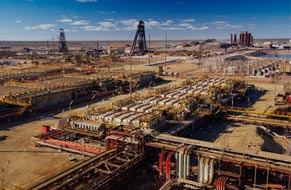Olympic Dam reserves upped by 22%
24 September 2009
BHP Billiton has announced significantly increased uranium ore reserves for its Olympic Dam mine in Australia.
 |
| Olympic Dam (Image: BHP Billiton) |
According to figures released by the company, within the overall mineral resource containing 2.45 million tonnes of uranium oxide, it now has economic reserves of 347,500 tonnes U
3O
8 (295,000 tU) at 0.059% average grade, compared with 284,000 tonnes in mid-2008. The 22% increase (63,500 tonnes) is due to additional mineralisation being reclassified as a result of ongoing drilling. The company also revised its anticipated reserve life upwards from 43 to 54 years.
Olympic Dam is a multi-mineral ore deposit some 560 km north of Adelaide. It is the world's largest known uranium orebody, as well as laying claim to the world's fourth largest remaining copper deposit, fifth largest gold deposit and significant quantities of silver. It produces uranium as a co-product with copper. Metallurgical recovery of uranium is only 73%, due to much of the uranium mineralisation being brannerite, from which uranium is difficult to extract (uranium is usually liberated from the host mineral by dissolving it in acid, but brannerite is more resistant to acid dissolution than other uranium-bearing minerals).
The mine produced 3344 tU in 2008, winning it fourth place in the world's top ten uranium mines and accounting for 8% of total world uranium production. However, BHP Billiton is looking to massively increase the size of the mine over coming decades, and earlier this year released a 4000-page draft environmental impact statement (EIS) on its proposed expansion plans. Government decisions on the draft EIS are expected by the middle of 2010, The proposed expansion would take 11 years to implement, and would see production of up to 19,000 tonnes U
3O
8 per year.